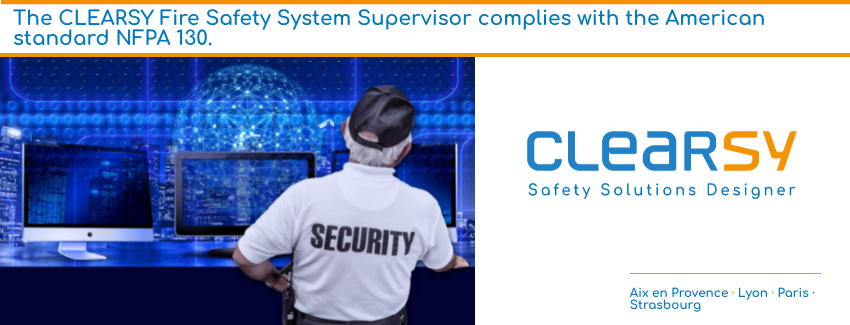
A standard analysis was performed to determine if the CLEARSY fire safety system (FSS) supervisor could be used in countries that apply the American FSS standard NFPA 130 (National Fire Protection Association). We identified the possible constraints of the French standards that are not mandatory in the American standard and the efforts to be made in order to comply with this standard as well as with those it references: NFPA 4, NFPA 72.
The NFPA 130/72/4 standards give the requirements for a Central Fire Safety Station (FSCC). This is not the case for the 61508 standards and even for the French fire safety standards.
The NFPA standards impose the following main constraints:
– Transmission, localization and display to the FSS of all detection points (fire/smoke), fire alarms, status of fire safety related equipment in less than 90 seconds (end-to-end communication)
– Interconnection and testing of communications between the different equipment according to NFPA 4 standard
– Allowing fan control from the FSCC and feedback that it is effective and correct
– Priority of local control (FSS) over remote control (FSCC)
– Detection of abnormal operating conditions (failure) in less than 200 sec
– Emission of a sound during a fire detection
– Detection of the impossibility of supervising one or more zones
– Detection of power failure of the FSCC and FSS
– Test of fire safety equipment
– Protection against software changes and unauthorized access
– Archiving of events for a period of 1 year
– Detection of any network failure (corruption, retransmission, loss of communication, insertion, etc.) within 200s
– End-to-end testing of the system before commissioning
The fire equipment (FSS and all equipment supervised by these FSS) are assumed to be compliant with NFPA standards related to fire safety.
The results of the analysis show that all the provisions made on the CLEARSY FSS supervision system are compatible with the American standards with one adaptation of the system configuration. The only adaptation identified by this analysis concerns communication with the supervised FSS if it is different from those currently managed by the CLEARSY supervision system.
The other aspect of the study shows that the application of the IEC61508 standard specialized in software development is better adapted to a supervision system whose safety layer is essentially carried by the software, than the NFPA 130 standard.